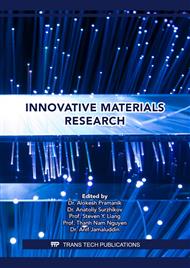[1]
I. K. Pohodnya Metod issledovaniya protsessa plavleniya i perenosa elektrodnogo metalla pri svarke. Avtomaticheskaya svarka 2 (1964) 1 – 10.
Google Scholar
[2]
Metallurgija dugovoj svarki. Processy v duge i plavlenie jelektrodov / I.K. Pohodnja, V.N. Gorpenjuk, S.S. Milichenko i dr. – Kiev: Naukova dumka, 1990. – 224 s.
Google Scholar
[3]
F. Wang, W. K. Hou, S. J. Hu et al. Modelling and analysis of metal transfer in gas metal arc welding. J. Phys. D: Applied Physics. 36 (2003) 1–19.
Google Scholar
[4]
P.F. Mendez, G. Goett, S. D. Guest High Speed Video of Metal Transfer in Submerged Arc Welding. International Institute of Welding. Seoul. Doc. XII-2196-14 (2014).
Google Scholar
[5]
V.A. Sudnik, V.A. Erofeev, A.V. Maslennikov, R.V. Tsvelev. Matematicheskoe modelirovanie formirovaniya svarochnoy vannyi pri dugovoy svarke pod flyusom i analiz protsessa perenosa metalla. Izvestiya TulGU. Tehnicheskie nauki. 6(2) (2015) 21–31.
Google Scholar
[6]
O. Semenov, V. Demchenko, I. Krivtsun et al. A dynamic model of droplet formation in GMA welding. Modelling and Simulation in Materials Science and Engineering 20(4) (2012) 045003.
DOI: 10.1088/0965-0393/20/4/045003
Google Scholar
[7]
I.V. Pavlov, A.O. Kotlubey. Raschet temperaturyi nagreva elektrodnyih kapel. Visnik PDTU. 16 (2006) 1– 5.
Google Scholar
[8]
V. A. Lebedev. Opredelenie ob'yoma perenosimoy kapli elektrodnogo metalla v usloviyah kolebaniy vannyi i elektroda pri dugovoy mehanizirovannoy svarke. Novi materiali i tehnologiyi v metalurgiyi ta mashinobuduvanni. 2 (2017) 95 – 99.
Google Scholar
[9]
V.P. Ivanov, E.V. Lavrova, D.P. Il'yaschenko, E.V. Verkhoturova, Modelling of fusion zone formation in shielded metal arc welding, Structural integrity and life. 3 (2020) 281–284.
Google Scholar
[10]
V. Ivanov, E. Lavrova, V. Burlaka, V. Duhanets, Calculation of the penetration zone geometric parameters at cladding with a strip electrode. Eastern-European Journal of Enterprise Technologies. 6/5 (2019) 57-62.
DOI: 10.15587/1729-4061.2019.187718
Google Scholar
[11]
V.A. Lebedev, T.G. Solomichuk, S.V. Novykov, Study of a Welding Harmonic Oscillation influence on the Welded Metal Hardness and Weld Bead Width. Journal of Еngineering Sciences. 6 (2019) 16–21.
Google Scholar
[12]
B.E. Paton, V.A. Lebedev, Ya.I. Mikitin. Sposob kombinirovannogo upravleniya protsessom perenosa elektrodnogo metalla pri mehanizirovannoy dugovoy svarke. Svarochnoe proizvodstvo. 8 (2006) 27–32.
Google Scholar
[13]
D.P. Ilyaschenko. Metodika rascheta ob'ema kapli rasplavlennogo elektrodnogo metalla MMA. Mezhdunarodnyiy zhurnal prikladnyih i fundamentalnyih issledovaniy. 9 (2015) 235–237.
Google Scholar
[14]
I.V. Lendel, S.Yu. Maksimov, V.A. Lebedev, O.A. Kozyirko. Vliyanie impulsnoy podachi elektrodnoy provoloki na formirovanie i iznosostoykost naplavlennogo valika, a takzhe poteri elektrodnogo metalla pri dugovoy naplavke v CO2. Avtomaticheskaya svarka. 5-6 (2015) 46–48.
Google Scholar
[15]
V.P. Ivanov, E.V. Lavrova, Improving the efficiency of strip cladding by the control of electrode metal transfer, Applied Mechanics and Materials. 682 (2014) 266-269.
DOI: 10.4028/www.scientific.net/amm.682.266
Google Scholar
[16]
E. Lavrova, V. Ivanov. Controlling the depth of penetration in the case of surfacing with a strip electrode at an angle to the generatrix. Materials Science Forum. 938 (2018) 27-32.
DOI: 10.4028/www.scientific.net/msf.938.27
Google Scholar
[17]
V.P. Ivanov, N.A. Makarenko, E.V. Lavrova, M.V. Ahieieva. Electric arc deposition of an anticorrosive layer with two strip electrodes. Solid State Phenomena. 303 (2020) 39-46.
DOI: 10.4028/www.scientific.net/ssp.303.39
Google Scholar
[18]
L.K. Leschinskiy. Osobennosti perenosa elektrodnogo metalla i protsessa legirovaniya pri naplavke lentoy. Svarochnoe proizvodstvo. 1 (1969) 10 - 11.
Google Scholar
[19]
B.I. Nosovskiy, A.I. Kovalevskiy. Razrabotka rezonansnogo preobrazovatelya elektricheskih kolebaniy v mehanicheskie dlya prinuditelnogo perenosa elektrodnogo metalla pri svarke v srede uglekislogo gaza. Vestnik PGTU. 24 (2012) 206-210.
Google Scholar


